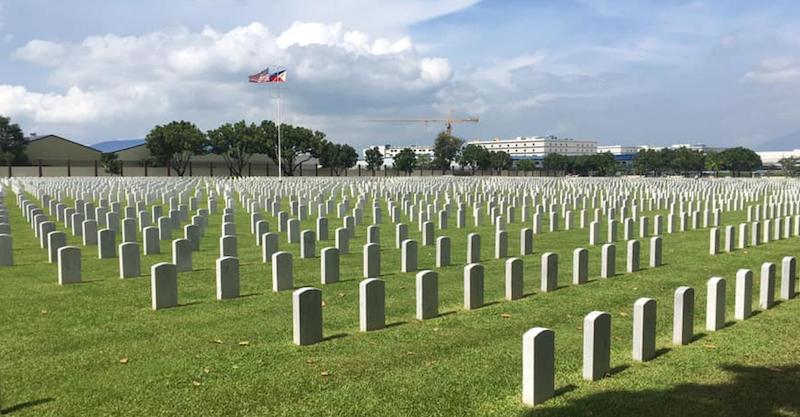Approximately 8,600 grave markers dot the landscape of Clark Veterans Cemetery, an 8.2 hectare property located along Manuel A. Roxas Highway. It was established in 1950, after the American and Philippine governments designated Fort William McKinley in Taguig, Metro Manila as the burial site for the over 17,000 casualties of World War II.
Remains from post cemeteries in McKinley, the U.S. naval base at Sangley Point (Cavite), and Fort Stotsenburg I and II (Clark) were then moved and consolidated to this present site. Buried here are Philippine Scouts, American servicemen and their dependents, civilian military personnel, refugees, and more than 2,100 unknown or unidentified casualties of past wars.
Clark Veterans Cemetery is maintained by the American Battle Monuments Commission (ABMC) and is the only site in Clark where the Philippine and American flags fly side by side.
Whilst the majority of all burials are American veterans, Philippine Scouts and their dependents, there are some exceptions authorized by the US Government for burial. For example, there are several hundred civilians who served in the US Army Quartermaster Department as teamsters, farriers, wheelwrights, blacksmiths and packers with the majority of these having served in the Spanish–American War and Philippine–American War. They died in the early 1900s when the Army relied solely on civilians to drive the wagons and tend the horses. A female civilian trumpeter who was assigned to the 9th Cavalry Regiment (United States) who died in 1916, and civilian Ordnance Specialists and the Chief Engineer of a US revenue cutter, a customs vessel, who died in 1906, are buried at the cemetery.
There are a few foreign nationals buried in the cemetery. All such burials are directly approved and authorized by the US Government. These persons died on the various military posts and include nine Vietnamese who were among the 30,082 boat people/refugees repatriated by the US Government in 1975 and processed through the Clark Air Force Base processing center and one French Navy Commander who died in 1905 and one Third Class Petty Officer of Chinese descent who was serving in the Royal Canadian Navy and died in 1956.
From the cemetery’s initial inception and existence on the various military posts from as early as 1900, through the consolidation and moves to Fort Stotsenburg in 1948, the cemeteries had been solely administered by the US Army and US Navy. In 1949 when the US Air Force assumed responsibility for Fort Stotsenburg and it was officially renamed Clark Field, the US Air Force assumed sole responsibility for managing the Clark cemetery. This was attested by the Commander, United States 13th Air Force when on July 4, 1984 he dedicated a memorial to the “last active USAF Cemetery outside the United States.”
By special agreement with the Philippine Government, the cemetery remains open for burials of American Veterans and Philippine Scouts. The VFW Post provides full military honors. There are an average of 40 burials a year, exclusively veterans, including many World War II and Vietnam era warriors. In 2004, a young soldier serving in Iraq was killed in an IED incident and is buried in the cemetery. He was the first Iraq War fatality to be interred in Clark Veterans Cemetery.
There are several monuments and commemorative memorials in the cemetery. The largest is a six and a half foot obelisk marble Monument to Unknown Dead. This monument was constructed of Vermont marble imported in 1907 and erected in the Fort McKinley cemetery and dedicated in 1908 by the Ladies Memorial Association of Manila. The monument was damaged during the fighting to liberate Manila in 1945 and later moved to the new Clark cemetery site in May 1948. A second smaller stone monument was dedicated on July 4, 1984 by the Commander of 13th Air Force honoring the cemetery at Clark as “The last USAF cemetery outside the continental United States”. A third monument exists adjacent to the main entrance of the cemetery. It is a Bataan Death March monument dedicated to fellow Elks, both American and Filipino, who passed within 100 yards (91 m) of the cemetery on the Death March trains that carried them from the City of San Fernando in Pampanga to Capas in Tarlac and on to their final imprisonment at the Imperial Japanese Camp O’Donnell prisoner of war facility.
In January 2013, the United States authorized $5 million to restore the cemetery, and placed the cemetery under the American Battle Monuments Commission, who will assume responsibility for cemetery maintenance. In February 2013, retired U.S. Navy Captain Dennis Wright said that an agreement still needs to be made between the United States and the Philippines in order for it to operate the cemetery which is seen as being a tourist attraction by the Clark Development Corporation. In December 2013 it was announced that Clark Cemetery would be taken over by the American Battle Monuments Commission.
Following the resumption of American maintenance of the cemetery, there was a dispute between the American and Philippine governments about who shall be authorized to buried at the cemetery in the future.[8] In December 2016, it was recommended that the cemetery name be changed to “Clark American Cemetery” and that it be negotiated with the Philippine government that the operation of the cemetery be changed to “in perpetuity”. By 2019, restoration of the cemetery, at the cost of several million dollars, was completed. Increasingly, the cemetery has become surrounded by Chinese-led new developments.







